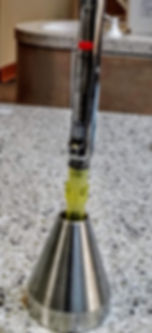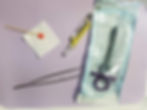Anesthesia Sharps Management To Keep You Hitting Your Best Shot.
Just a few weeks ago I was at a clinic (I won’t say where, but it’s a place where EVERYONE knows better) and observed a dentist handing the UNCAPPED Syringe to the dental assistant…. POINTY END FIRST!!!
I can’t believe that I am writing about this. It should be common sense, but alas some clinicians still need a few reminders.
Let’s look at some basic safety items when it comes to needle management.

First, don’t have your hand (or anyone else’s) near the sharp pokey end. Practice uncapping the needle with only one hand. If you have an assistant to help you with your procedures, that’s totally awesome, but is uncapping your needle really something you need help with? If you do, have your assistant gently loosen the lid and you can uncap it the rest of the way. What about when you are all done? Use a capping device. There are several of them available from a simple piece of cardboard with a hole in it to a variety of sterilizable metal holders. If you don’t have any of those around, the good old fashion scoop technique is always a winner.

To avoid playing chase the cap, use your locking cotton pliers and hold the cap in place.

Speaking of locking pliers, do you have those on your tray? Locking ones are the gold standard, but if you don’t have those grab your regular cotton ones. Not only do these come in handy with recapping and grabbing items from your drawers, but in the event of a mishap like the needle breaking in your patients’ mouth, it will be your go to safety retriever. This is where the Boy Scout motto “Be Prepared” comes into action. When you are prepared for an urgent situation, it either won’t be that big of a deal or won’t actually happen.
Along with that thought, make sure you don’t hub your needle. If your needle hub is all the way to the mucosa and then the patient moves causing the needle to break, the mucosa will spring right over that needle making it disappear into all that soft spongy tissue. And then you have a new issue on your hands! A great way to avoid this from happening is using the correct needle length for the injection and make sure you have at least 3-4 mm of needle showing.
Safety during your injection is important too. Using retraction devices can keep your fingers out of clear and present danger. However, if you are like me and like to use finger retraction, make sure you create enough space between you and the injection site. Syringe stability is key to avoiding accidental needle sticks as well.

Now once you are all done with your injections and you have safely recapped your needle, it’s time to dismantle your syringe.
Here are a few things to keep track of as well.
When taking the needle off the syringe I encourage you to hold it near the hub and twist the syringe to unscrew the two parts from each other. Again, you can use those pliers to hold it for you! Please do not grasp with your hand over the cap. I have seen way too many times where the needle bends out the side of the cap or it falls off the needle, creating a potential sticking point for yourself.
When dropping the needle into your sharp’s container, it should easily fall into the bin. Double check and make sure your container isn’t past the full line or has a stockpile on one side. Gently tap the side of the container to even out the sharps, then drop your sharps inside. Never use your finger/hand to push the needle into the sharp’s container! Several years ago, a former student of mine was distracted when she was placing her needle into the sharp’s container. The needle didn’t go down all the way, and not even thinking she tapped it in with her finger. This caused a deep puncture wound on her index finger. To make the situation even scarier for her and all involved, the patient was being treated for a blood borne pathogen too. Talk about a stressful situation.

By the way when was the last time you looked at your sharp’s container? I hope you have one in every operatory and in your sterilization area. Next time you are near one, double check how full it is. If it is full, close the lid and switch it out. This is a great task for one person in the office to oversee as well.
Another thing to look at, is if the container lid has its own plier/needle remover with it. Talk about making your sharps disposal easy! Remember, the needle and the glass anesthetic cartridge are what go inside the sharp’s container. If the rubber stopper comes out of the cartridge you can put that in your regular trash. Same for the cardboard recapping holders.
Following these simple steps can keep your patient care safe and effective. Plus, it will only add to your confidence of hitting your best shot!
CHEERS,
Tina
Get your FREE Anesthesia Placement Guide here at www.teachertinardh.com
For continuing education courses visit www.teachertina.thinkific.com
.png)